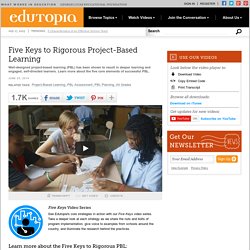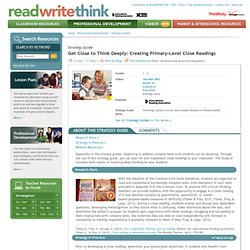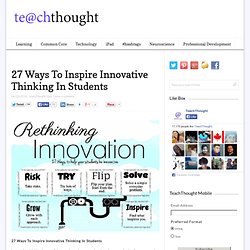

Beyond PowerPoint. Five Keys to Rigorous Project-Based Learning. Voiceover: How will today’s children function in a dangerous world?

What means will they use to carve the future? Will they be equipped to find the answers to tomorrow’s problems? Teacher: When you think about traditional learning you think of a student sitting in a classroom and being talked at. Teacher: Now I imagine a lot of you are still thinking... Teacher: They are supposed to be a sponge. Peggy Ertmer: So there are a lot of different ways to approach PBL, a lot of different ways to implement it, but really it all boils down to five essential keys: real-world connection, core to learning, structured collaboration, student driven, and multifaceted assessment. Student: One of the problems in the ocean is that with the higher amount of CO2 calcifying organisms are decreasing and we’re testing to see how well life in the ocean lives without calcifying organisms.
Student: --four by eight feet. Peggy Ertmer: So the second commonality is the PBL unit provides academic rigor. Student: Yes. Brain-based learning, ideas, and materials. Brain-Based Learning: Resource Roundup. Edutopia's list of resources, articles, videos, and links for exploring the connection between education and neuroscience.

(Updated: 12/2013) Building Brain Literacy in Elementary Students, By Judy Willis, M.D. (2013) Neurologist, teacher, author and Edutopia blogger Willis discusses the benefits of teaching elementary students how their brains work. Brains, Brains, Brains! How the Mind of a Middle Schooler Works, by Heather Wolpert-Gawron (2013) Blogger Wolpert-Gawron launches this three-part series by advising middle school teachers to read up on brain research with insight on how the 'tween brain works. In her second blog, The Mind of a Middle Schooler: How Brains Learn, read about important brain terminology and a typical classroom scenario where a middle schooler's brain is hard at work. iTunes U - Open Professional Development.
PD in Your Pocket - Open Professional Development. Youpd. Videos, Common Core Resources And Lesson Plans For Teachers: Teaching Channel. TeachThought : 27 Ways To Inspire Innovative ... Get Close to Think Deeply: Creating Primary-Level Close Readings. With the adoption of the Common Core State Standards, students are expected to read and comprehend increasingly complex texts, with exemplars of such texts provided in Appendix B of the Common Core.

To promote this critical thinking, teachers can provide students with the opportunity to engage in a close reading of a text deemed complex by quantitative, qualitative, or reader-based/purpose-based measures of difficulty (Fisher & Frey, 2012; Fisher, Frey, & Lapp, 2012). During a close reading, students answer and discuss text-dependent questions, developing metacognition as they notice what is confusing, make inferences about the text, and determine the author’s purpose. As students gain experience with these readings, struggling and succeeding in their interactions with complex texts, the materials they are able to read independently will increase in complexity as reading responsibility is gradually released to them (Fisher, Frey, & Lapp, 2012).
Useful Teaching Websites. 27 Ways To Inspire Innovative Thinking In Students. 27 Ways To Inspire Innovative Thinking In Students Innovating thinking is one of those awkward concepts in education–one that is often espoused, but isn’t measured, reported on, trained around, or celebrated.

It’s just sort of there. Innovative thinking in students will flower when we design classrooms that absolutely can’t survive without it. Seven Free Online Whiteboard Tools for Teachers and Students. This afternoon through the Free Technology for Teachers Facebook page I received a request for some free whiteboard apps.

All of the following seven tools can be used to draw and type on a whiteboard in your browser. With the exception of PixiClip all of these tools can be used collaboratively for brainstorming sessions. While PixiClip doesn't allow for collaboration it does have a voice-over capability. Sketchlot is a free collaborative whiteboard service that works on any device that has a web browser. I tested it on my MacBook, my iPad, and my Android tablet. Aww App is a simple browser-based application for creating drawings. PixiClip is a great new tool tool for creating, narrating, and sharing drawings. Stoodle is an online whiteboard service supported in part by the CK-12 Foundation. Draw It Live is a nice little website that offers a free space for you to instantly create a collaborative whiteboard to use with anyone you like.
Bloom's Pyramid Interactive. Teaching like it's 2999. 44 QR Codes Resources For Teaching & Learning.